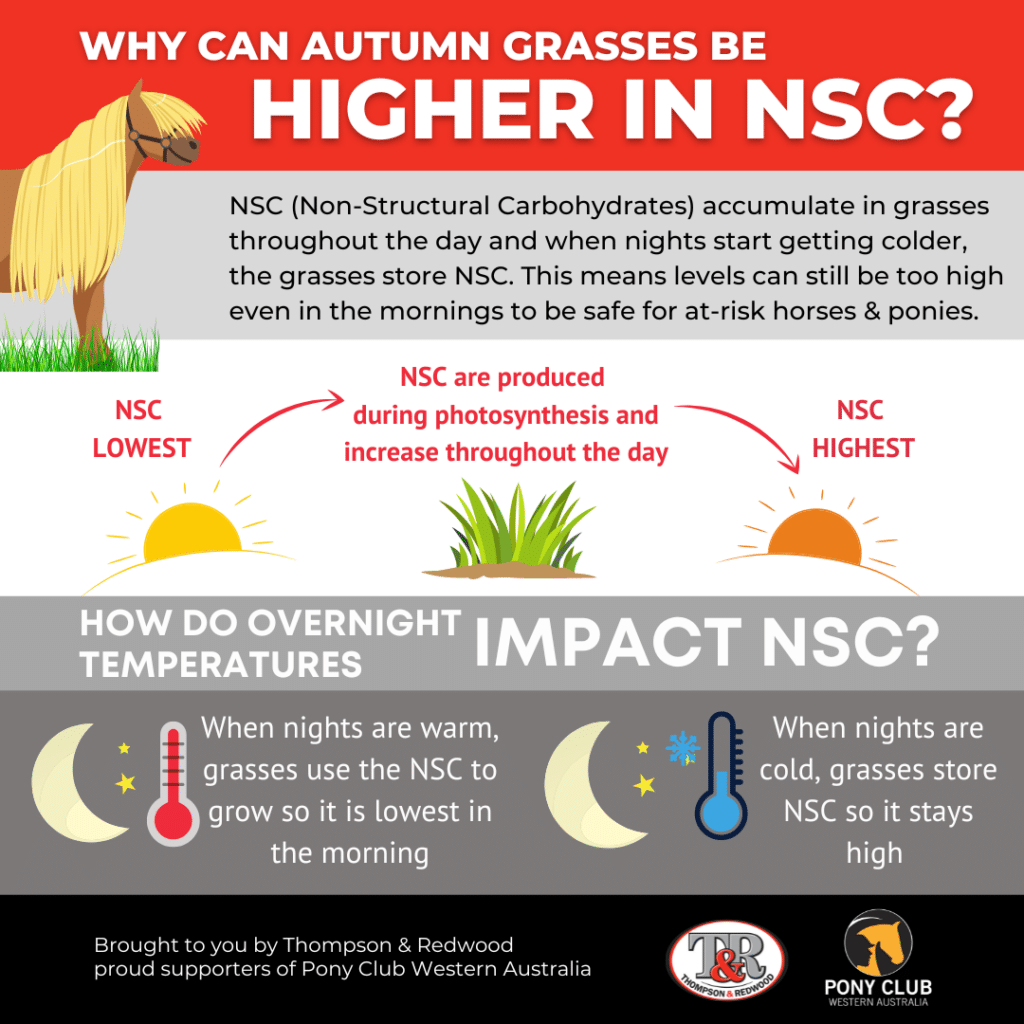
04 May Managing Laminitis-Prone Horses in Autumn
With Autumn upon us and winter rains starting, there will be a few fresh, sweet green shoots coming through in our paddocks.
If you have a horse prone to laminitis, Autumn can be a very risky time! We’ve covered what laminitis is with Dr Brad Hampton in a previous blog post. A lot of people think of spring as the riskiest time of year for laminitic horses and ponies, but did you know that autumn and winter conditions can pose just as much risk?
Autumn Weather & NSC:
When grasses (both C3 and C4) have a flush of growth and are exposed to bright sunlight and dropping temperatures like we see in autumn, they accumulate Sugar and Starches or Non Structural Carbohydrates (NSC) in their leaves. This increases the risk to laminitic and insulin resistant horses, as simple sugars and starch are digested in the foregut and can raise blood insulin levels.
What are NSC? They’re are the total amount of sugar, starch and fructans measured in a feed source. They can be determined by adding the Water Soluble Carbohydrates (WSC – simple sugars and fructans) to starch.
Fructans & Frost:
Fructans are important when we talk about laminitis, as they are highly fermentable in the hindgut and when consumed in high volumes can lead to laminitis through endotoxins. Fructan levels in grass change throughout the day, and are usually at their highest in the afternoons due to photosynthesis. However, frosty nights can slow down the metabolism of pastures. This means that the fructan levels can still be very high in the mornings. If you have to graze your laminitis-prone horse, make sure you watch the conditions and try to restrict the grazing to safer times.
Stressed pastures:
A pasture that is under stress, i.e. pasture that is coming out of drought or pasture affected by frost can accumulate higher levels of NSC and be more dangerous to laminitic horses and ponies. Autumn often covers both of these, because pastures are coming out of a hot summer and receiving their first rains for growth as well as getting their first frosts.

So how do you manage this?
our top tips for autumn grazing management:
1. Seriously Restrict Grazing Time:
Try to restrict your horse’s grazing time as much as possible. This is very important for pastures that have received recent rains, or are within a growth phase. Pasture during autumn is very risky to laminitic horses in many ways, so the safest bet is to strictly limit grazing time.
2. Graze inside ‘safe’ times and conditions where possible:
The safest time to graze is first thing in the morning, when NSC are at their lowest. However, when pastures are considered high-risk, they may not be safe at any time of the day. Aim to take your horse or pony off pastures within a few hours of the sun coming up. If you do let them out onto pasture – try to make sure they have a full belly of hay first, they’ll be less likely to gorge themselves on grass.
3. If in doubt it is better to have them on suitable hay
If you are worried about grazing, it is safer to keep your horse or pony locked off grass, and feed meadow or rhodes grass hay, that has been tested and is low in sugar and starch instead. You might need to add Vitamin E and Vitamin C if they haven’t had access to green feed for a while though.
4. Feed a low sugar and starch diet that is laminitis safe:
Make sure any hay and hard feed you offer is suitable for laminitic horses and ponies, i.e. feeds that have low Water Soluble Carbohydrates (WSC = Sugar & Fructans) and low NSC (Non-Structural Carbohydrates = WSC + Starch). This includes tested meadow or rhodes grass hay, and means avoiding hays and chaffs like oaten, wheaten or barley.
Keep an eye on the sugar and starch levels in your pellets or cubes too, as not all low starch feeds are laminitis and metabolic condition safe.
OUR Diet Recommendation:
Feeding a laminitis, cushings or EMS prone horse doesn’t need to be difficult. There are simple and cost-effective feeding options that can help you control these health issues.
We’ve formulated and created our laminitis-safe range, which are all ultra-low in starch and sugar and safe for not only laminitis but metabolic conditions like EMS, IR, PPID (cushings) etc and ulcers. Our laminitis safe range includes Calm Care Plus, Lupin Fibre Boost and Lupin Fibre Cubes.
These feeds include ingredients like lupins and lupin hulls, which are a safe option for horses with insulin issues, as when digested, they do not cause large spikes in insulin or blood sugar fluctuations that can lead to these health problems.
- Lupins hulls are packed with quality proteins, with half the protein of whole lupins, making them a more versatile ingredient, as whole lupins are very high in protein, so should not be fed in large amounts.
- Lupin hulls are a quality source of digestible fibre, which is essential in healthy gut fermentation and has a prebiotic effect, feeding the good bacteria in the gut.
- They are a good source of cool energy, so don’t fizz your horse or pony.
- Lupins are cost effective, as you do not need to feed large amounts to satisfy their nutritional requirements.







B & C Reside
Posted at 04:32h, 30 AprilThankyou for the very important reminder Thompson and Redwood
We can highly recommend Dodson and Horrell’s Lamifree which we currently use to help maintain soundness and happiness for our main man Rolle ???????? he thrives on his herbal supplements and managed diet, especially during the autumn season where risks of laminitis are higher. A great read ????????